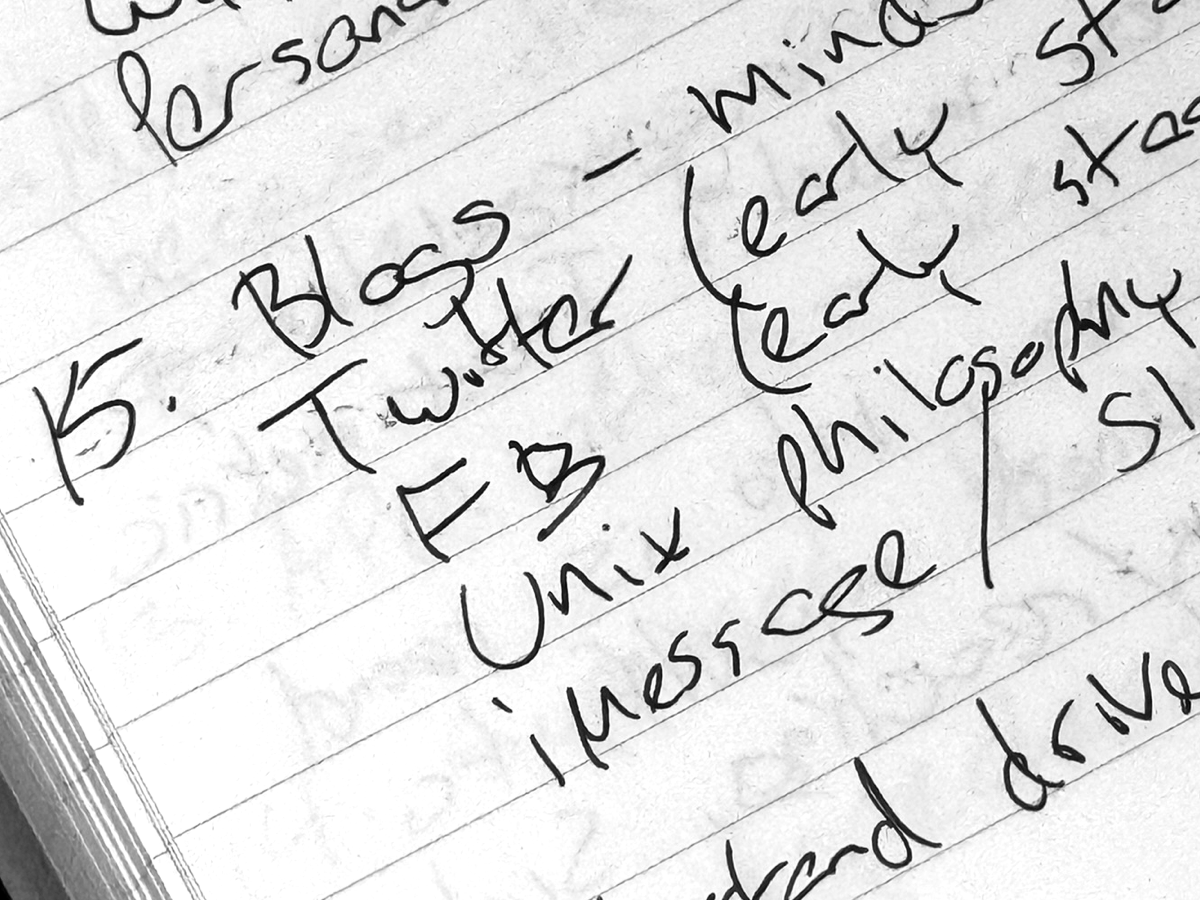Michell Zappa is the founder of Envisioning.io “the world’s first collaborative platform for technology intelligence”. We heard about what sparked the idea for Envisioning and where it’s headed next.
“Envisioning started 2011, the idea for the company was first sparked six years ago (2008) when I was piecing together a keynote for a conference I had been invited to speak at.” At the conference, he was going to be speaking about the future of technology in the next 5 years (projecting for 2013) - things like 3D printing, geo-location, space tourism etc.
“At first, I tried to avoid the commitment at all lengths, I had to be invited 2 or 3 times because I was feeling that I had no pretense for speaking at the conference. At that time, I was a designer at a trends company called Trendwatching and vaguely involved with forecasting.” It is a time that he references as “his MBA” where he “learned the fundamental skills for bootstrapping and DIY-ing”, which now reflects back as being essential to building a company. His friend was so adamant and persuasive that in the end he committed to the engagement, thus contributing to his future career direction, Envisioning itself, and where he is today.
“It was a year later (2009), that I went back to the keynote, wanting to update the story and broaden it; I ended up turning it into a 300 slide document. This was the key turning point, where I determined that keynote was probably the wrong media and ended up creating an infographic as they’re much better for explaining non-linear formats”. He spent another few months researching, piecing together and organizing different technologies into a visual. He then promoted it online, showed it to a bunch of people including editors, journalists and tech writers, especially those that inspired him, and got quite a bit of traction online – “it was picked up by a blog, then picked up by Fast Company”. The traction he received was “a divine signal” saying that he was moving in the right direction – he subsequently spent the next year running things in parallel while remaining at his day job. The most appropriate word he could come up was “envisioning” for what he was trying to do, thus becoming the name of the company. “As the website and infographics gathered traction and interest by people, I was asked to do bespoke work, speak at conferences; slowly people started noticing and requesting spin-off work.”
“In 2012, I decided to leave my day job and starting this month (March 2017) I’ve been working on Envisioning for five years full time.” The company grew as he devoted more time and effort overall. He began publishing accessible intelligence on technologies, “I have always had the same objective, what has changed today is the size and scale. At first, Envisioning was a one man operation then he slowly started convincing friends to work with him and people started getting involved on an experimental basis.” His hiring strategy was on a very gradual basis: “give people the option to try, see if they like working with us and eventually they’ll get some money and get more involved”.
On constraints
“Envisioning has faced lots of constraints, for one it has been entirely self-funded, never having outside investment, which was very much on purpose. I had pre-determined runways where I would have time to experiment, try things out, all without owing anything to anyone; nothing was ever obliged and that principle has stuck with the company throughout its life.” Rather than leading a normal corporate or traditional startup where it’s necessary to turn profit at some point, he’s been able to reinvest everything into the company and steer it forward. He describes the core offering to be “similar to IMDB’s database except I’m building a technology database that tracks hundreds of technologies with news updates”. Envisioning tracks that data and has been developing it into a service; no client has ever asked for them to do this meaning the core offering is the result of continuously reinvesting in the company over time. “We’re building things that we believe are relevant to the business even if there isn’t a client need for it”. All the research and development Envisioning does is for themselves: “we want it, we think it’s useful and then we’ll end up carving out a market for it”.
Michell hones in on three core milestones that have contributed to the overall growth and trajectory of the company.
The core offering, the visualization tool was developed independently by Envisioning. It builds on the original 2011 version Michell designed and ultimately builds on the overall vision of the company. The tool itself does a good job at navigating complexity and even though each visualization will look different, it leverages the same code, the same information in a research report and is interactive which engages people really well. Envisioning never had a client brief to create this tool, the drive to create it was based on the desire for it to exist and the projection that there would be demand for it in the future. There was always this underlying drive on the development side of the tool versus the drive based on client need.
Working on projects to show what they’re made of and what they can create. For example, Zero Hunger was created using available resources to “do something different”, they were contacted by someone at the World Food Programme (WFP) and created this visualization as a showcase to leverage future engagements, ultimately build for mutual benefits of Envisioning and WFP; there was no exchange of a briefing or money. Currently Envisioning has many engagements on-the-go, all very different and all highly experimental with the ultimate goal that the result in concrete learnings that contribute to value creation in the future. They operate on the intention that practice makes perfect and creating things for both experimentation and experience can be leveraged to create further value in the future.
What’s next?
“Our business model so far has been highly focused on one-off engagements; a client could be a private healthcare company that asks to do some additional research into health technologies, they could be commissioned to do 3, 6 or 12-month engagement. There’s generally very little recurrence in projects.” Now, Envisioning is facing a pivot that they’re presently focusing on; “We want to transition towards a platform offering and subscription system; this core database will become the focus of our business model instead of one-off client engagements”. With this platform, “the goal is to have the most comprehensive database of technologies in the world and sell access to it”. Right now, Envisioning uses an internal web application to manage the research process on other projects and aggregate technologies worldwide. They have really good coverage in fintech, health tech and agriculture, but are lacking in areas like energy, mobility, and clean tech. Before launching, they need comprehensive coverage then on the marketing side they need to sketch out the unique value offering that it provides; “since there’s nothing quite like it on the market the challenge is explaining it in a compelling way”. Michell says that he’s known since day 2 that this transition would happen to focus on establishing necessary visual language that’s interactive in nature beyond a static infographic, whereas day 1 the core need was establishing that initial visual language. He explains that he has always known that it would come to this direction at some point.
For Envisioning, the most fundamental underlying driver for growth is “telling a story that retains the complexity of information without dumbing it down, ultimately to drive appreciation for the wealth of everything going on”. In the world of technology, everything is rapidly changing and moving simultaneously; there’s a lot of people talking about the changes in technology going on, but there’s still no apparent middle ground between fast tech news (e.g. gadget blogs, WIRED) and technology experts (big thinkers, keynotes). “An individual falls into one of two categories: following tech news or following the big thinkers , but never in-between. That’s what Envisioning is trying to solve: the platform we’re building is a tool to retain that complexity while still remaining big picture by tracking the sheer amount of things that are moving towards us at such a fast pace. That underlying nugget about hundreds of things moving towards you at lightning speed is a shift that’s really hard to produce, you can’t convey it in a keynote or in a visualization relevant to a specific industry, sector or livelihood. Once this platform is in place, then the objective is to nudge people towards it.”
“One of the challenges Envisioning faces is keeping everything up-to-date especially while making the move from bespoke work to platform. With the current subscription model we’re transitioning towards they have models/rules for updating the data. We have a survey model to assess the readiness of each technology which can be completed repeatedly and modeled to track updates.” Right now, they aren’t able to devote a lot of time to this recurring model because of resource allocation; client work is the focus. The requirement is to have the right incentive models for the right people to keep it up-to-date; “keeping current and fresh is a considerable challenge, putting it into the design of the tool itself is imperative; some innovation databases are useless past the front page.” “There’s no incentive for publications to update all the data, and we’re designing around that issue as both a software development challenge and a research challenge.” “It’s huge and something that makes or breaks the platform.”
On other challenges
“Complexity is always an issue, the work itself is complex and explaining our work is also complex; you get used to it at some point and it becomes hard to explain to outsiders what we do because there are so many moving pieces and you ultimately need that degree of complexity; that’s the underlying paradox that we can’t move away from. It’s possible to simplify some aspects of it, but we’re never going to completely illuminate the complexity of our work.” “The demand from clients is proportional to what they understand about our work; the more qualified they are, the better work we can do; all we have to do is explain that.”
On impact
“Our impact has been fairly model, we had a lot of impact initially, but subsequent projects have generated much less impact; we’re controlling the dials and levers that turn work requests into something sustainable with a business proposition.” “Ultimately, we’ve decreased our focus on impact and refocused on the platform, which is going to be a turning point. “If we can systematically offer this kind of intelligence to a large amount of people in a structured way by categorizing people to make the platform sustainable, impact will ultimately come from that.” “We could provide free access to academic institutions and potentially become the next Wikipedia.”
On Envisioning’s team
“The team is a mix, there are four categories of people with 10-15 active people with others joining sporadically. For researchers, there’s one person in charge with a handful of others who join on different projects for different capacities. For development, there are four people involved in coding and building. For design, there are two people and in operations there are a few people. Then there’s an R&D studio, as we have a lot of R&D going on. Everyone got involved through different means, all of them initially through volunteering to test to see if there’s a fit. It was a successful way of getting people involved. All Envisioning’s work is done online “more of a reality; it’s a condition for how the work could take place, we have no budget for offices, so it initially started as a need and then it became a condition - it brings advantages and disadvantages. We do as much as possible to minimize the impact by talking a lot and meeting up whenever possible.



